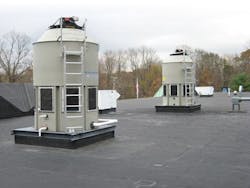About the author: Ed Sullivan is a technical writer based in Torrance, Calif. Sullivan can be reached at 310.787.1940.
In the early 1980s, the first personal computers were running the DOS operating system, the DeLorean “Back to the Future” sports car hit the street, and Sony was offering its Betamax video cassette player and the Walkman personal music player.
The year 1981 also saw the introduction of the world’s first 150-ton molded seamless plastic cooling tower. Featuring a seamless high-density polyethylene (HDPE) shell, this design essentially was impervious to the corrosion problems that plagued conventional, metal-clad cooling towers, which resulted in exorbitant downtime for frequent repairs or replacement.
Non-Stop Operation
Today, after 34 years of virtually continuous operation, some early HDPE cooling towers are still running, including the one installed by chemical manufacturer Ardmore Inc. in Newark, N.J.
Ardmore’s cooling tower was the second Paragon unit manufactured by Delta Cooling Towers Inc. In the early 1970s, Delta developed HDPE towers with forced draft models ranging from 10 to 100 cooling tons. The Paragon model that Ardmore installed was introduced in 1981 as a line of induced-draft, counter flow designs that offered 55- to 250-cooling-ton capacities. Ardmore’s unit is a 150-ton model.
When he first looked at the HDPE cooling tower, Ardmore president Albert Sharphouse noted the unitary plastic shell.
“We chose the Delta tower because plastic is non-corrosive, so it would last longer,” Sharphouse said. “Secondly, we use city water for makeup in the cooling tower, and the HDPE shell design would not require expensive water treatment chemicals (only dichloride tablets are used), so that would provide
ongoing economies.”
Ardmore, which manufactures a variety of chemicals, uses the cooling tower to extract heat from the water flowing through the heat exchangers and jacketed production vessels as well as a process flaker. Sharphouse noted that, while some of the chemicals and allied products that his company produces have changed over the years, the application and cooling system equipment have remained the same.
Exposed to the Elements
Located on the roof of the building, the cooling tower’s design gives it a distinctive, somewhat futuristic look—less industrial-looking than many traditional towers, said Ardmore’s mechanical engineer, Walter Sommer.
“Although we’ve now had the tower a long time, it still looks great,” Sommer said.
Cooling towers are exposed to continuous evaporation, salts and other aggressive elements that contribute to corrosion. In some cases, towers are affected by other destructive factors such as acids, aerosols, salt air or other contaminants.
When a cooling tower has to be replaced, the consequential downtime can be noticeably damaging to the owner’s production schedule and bottom line.
Sommer added that the HDPE tower provides an additional green benefit because it does not require harsh water treatment chemicals.
The HDPE cooling tower has additional green attributes, including improved sustainability, greater energy efficiency, added water conservation and a smaller carbon footprint.
Sommer said maintenance and downtime have been minimal, as well. While he has replaced the motor and bearings over the years, in the overall, service has been nominal.
A two-speed motor powers Ardmore’s cooling tower fan and water circulator with a belt-driven fan. Sommer is happy with the belt-driven design.
“The motor with the belt drive has been very reliable over the years,” he said. “In the summer time, we run it on high, and in the winter time we just switch it over to low speed. That is part of the beauty of the cooling tower’s design simplicity, and why it has been so good for our application.”
Although Delta’s cooling tower designs have evolved since the 1980s, offering a variety of single and modular design with up to 5,000-cooling-ton capacities, the company still offers Paragon Series models. The company also offers engineering and installation assistance.
Download: Here
